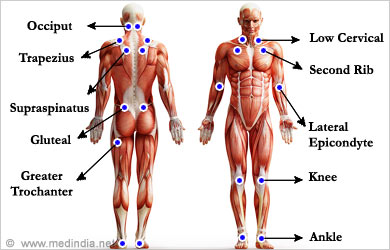About
A patient with myofascial syndrome suffers from pain at trigger points, which is referred to other parts.
Myofascial pain syndrome is a condition where the patient suffers from pain originating from specific pressure sensitive points located within a taut band of muscle tissue. These pressure sensitive points are called myofascial trigger points.

Myofascial pain syndrome often follows trauma or overuse of a muscle. The trigger points feel like nodules in the taut bands and are painful to touch. The pain also spreads to other parts and is called referred pain. Pressure over a trigger point produces a local twitch response. An active trigger point can cause pain at rest and pain that is referred to other sites. A latent trigger point may interfere with movement or cause muscle weakness, but is usually not associated with pain at rest.
Myofascial pain syndrome often resembles fibromyalgia. While myofascial pain syndrome shows the presence of trigger points, fibromyalgia is usually associated with tender points near the end of the muscle. Pressure on these points usually does not elicit referred pain. The two pain disorders require different treatments. Therefore, it is necessary to differentiate the conditions clinically.

Though myofascial pain syndrome is not life-threatening, prompt treatment is necessary as it may worsen overtime leading to other complications. Treatment involves medications to relieve the pain, needling of the trigger points and other approaches which include stretching and treatment of the underlying cause.





